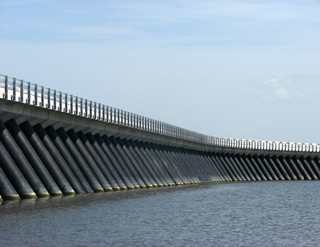Platinum Award
Project: Inner Harbor Navigation Canal/Lake Borgne surge barrier
Client: U.S. Army Corps of Engineers

Photo by Paul Floro Tetra Tech INCA managed the design of a surge barrier, including this 10,000-foot-long concrete barrier wall to block storm surges outside New Orleans. The surge barrier is the largest of its kind in the world.
(Editor’s note: This caption has been changed to clarify Tetra Tech INCA’s role in the project.) |
The Inner Harbor Navigation Canal/Lake Borgne surge barrier is a 10,000-foot-long, 26-foot-high concrete barrier wall extending from the Mississippi River Gulf Outlet to the Gulf Intracoastal Waterway.
The $1.1 billion barrier wall is the central feature of the U.S. Army Corps of Engineers’ efforts since Hurricane Katrina in 2005 to mitigate the risks of massive flooding in vulnerable areas of southeastern Louisiana.
It is the largest civil works design-build project in the history of the Army Corps of Engineers, and the largest surge barrier of its kind in the world. The barrier wall has essentially moved the first line of defense against storm surges 12 miles away from the heart of New Orleans.
The project, which finished in 2011, was completed a year early.
Tetra Tech INCA’s design included two 150-foot-wide gates at the Gulf Intracoastal Waterway, a 56-foot-wide vertical lift gate with a vehicular bridge, and the capability to create a complete floodwall closure of the Mississippi River Gulf Outlet. Extensive early modeling and testing of the proposed design were performed to confirm its strength and capabilities in the face of hurricane-force waves.
The proposal to build a surge barrier rather than raise and strengthen the existing 30 miles of levees and floodwalls was not well received by the people of southeastern Louisiana initially, but a public outreach effort involving 250 tours of the barrier site by 3,000 visitors helped restore public confidence in the project.
Project engineers kept environmental sustainability at the forefront of their efforts, which included installing fish ramps through one of the gates, minimizing the project’s ecological footprint, and protecting endangered species, especially manatees, during construction.